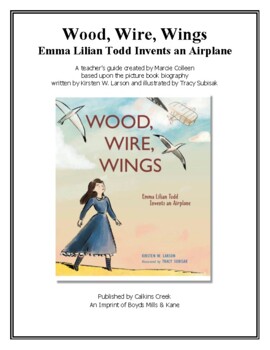Educator's guide for WOOD, WIRE, WINGS: Emma Lilian Todd Invents an Airplane
- PDF
Description
About the book: This riveting nonfiction picture book biography explores both the failures and successes of self-taught engineer Emma Lilian Todd as she tackles one of the greatest challenges of the early 1900s: designing an airplane.
Emma Lilian Todd’s mind was always soaring–she loved to solve problems. Lilian tinkered and fiddled with all sorts of objects, turning dreams into useful inventions. As a child, she took apart and reassembled clocks to figure out how they worked. As an adult, typing up patents at the U.S. Patent Office, Lilian built the inventions in her mind, including many designs for flying machines. However, they all seemed too impractical. Lilian knew she could design one that worked. She took inspiration from both nature and her many failures, driving herself to perfect the design that would eventually successfully fly. Illustrator Tracy Subisak‘s art brings to life author Kirsten W. Larson’s story of this little-known but important engineer.
Praise for WOOD, WIRE, WINGS:
“A heroine of the skies is given her due….(a) person who disappeared into history after adding to the knowledge of the era, Todd is resurrected here as a role model who can provide encouragement and inspiration by virtue of her single-minded dedication and resilience…(e)nergetic, thoughtful text punctuated by Todd’s own words and Subisak’s inventive, warmly outlined full-color illustrations follow her life….(c)elebrates its subject’s resilience as much as her contributions to STEM and aeronautics.” — Kirkus Reviews
“This inspiring work shines a light on a lesser-known inventor who was the first woman to design an airplane. An excellent purchase for public and elementary school biography collections.” — School Library Journal
“In tribute to the hands-on spirit of all inventors— but especially women—Larson profiles a little-known, self-taught engineer who designed a working aircraft that improved upon the Wright brothers’ model. In windswept digital watercolors, Subisak depicts her as an active, confident figure. Back matter… includes a comprehensive source list and a general time line of aviation in the Wright era. Todd herself was not a pilot, but her story pairs naturally with those about the first generations of female aviators.” — Booklist





